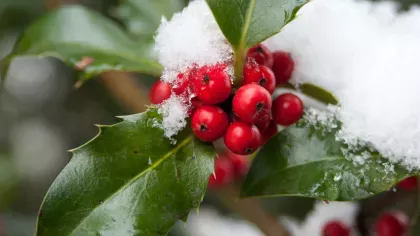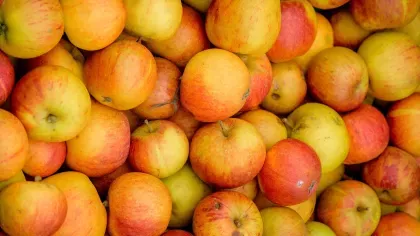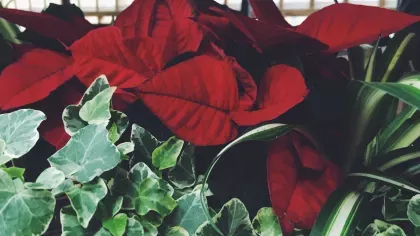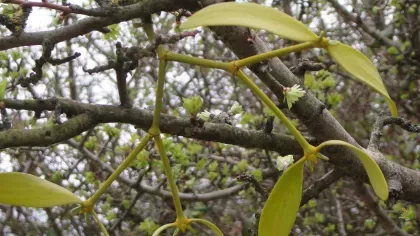
Mistletoe
On this page
Nothing says Christmas like a kiss under a poisonous parasitic evergreen plant, right?
Mistletoe grows from inside the branches of trees, including apple, oak and lime, stealing away nutrients and water.
Before becoming a festive favourite, mistletoe was highly valued in ancient Greek, Roman and Celtic culture.
But we don’t actually know exactly where the kissing tradition originated from.
All parts of mistletoe are toxic to humans, with the leaves and stem being more poisonous than the fruits.
Plant description
Mistletoe is a small woody shrub with a roughly spherical shape that can reach around 1m across. It grows on the branches of other trees, attached by a swelling known as a haustorium.
The stems fork out at semi-regular intervals, finishing with long, oval shaped pale green leaves. The small yellow-green flowers are produced in clusters of three to five flowers where the branches fork. The berries are spherical, white, around 1cm across and contain a single green seed surrounded by a sticky pulp.




Plant uses
Cultural
Mistletoe is a popular Christmas decoration.
Druids traditionally used mistletoe as a medicine and an aphrodisiac.
The ancient Romans linked mistletoe with peace and love, and would display it over doorways to protect the building.
Food and drink
Biska, a type of grappa brandy popular on the Istrian peninsula, is made from mistletoe.
Health
Extracts from mistletoe are used in some anti-cancer drugs, although there is limited clinical evidence of its effectiveness.
Materials and fuels
A sticky substance made from mistletoe berries, sometimes called birdlime, is used by hunters to trap birds.
Did you know?
Mistletoe berries are a popular food for birds. After the birds digest them, the seeds are excreted onto branches, where they can begin growing on a new tree.
You can estimate the age of a mistletoe plant by counting the number of times that the branches fork and adding two years.
In Norse mythology, Loki tricks the blind god Hodur into killing his brother Baldr with an arrow made from mistletoe.
Where in the world?

Growing from the branches of trees, in temperate regions.
Find it in our gardens
Kew Gardens
A botanic garden in southwest London with the world’s most diverse living plant collection.
Location
View map of Kew GardensBest time to see
Wakehurst
Kew’s wild botanic garden in Sussex that has over 500 acres of plants from around the world and is home to the Millennium Seed Bank.





